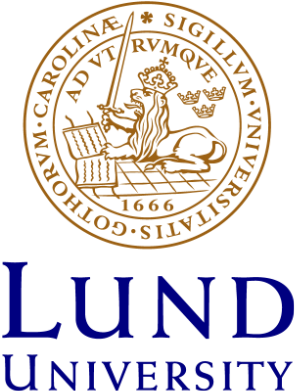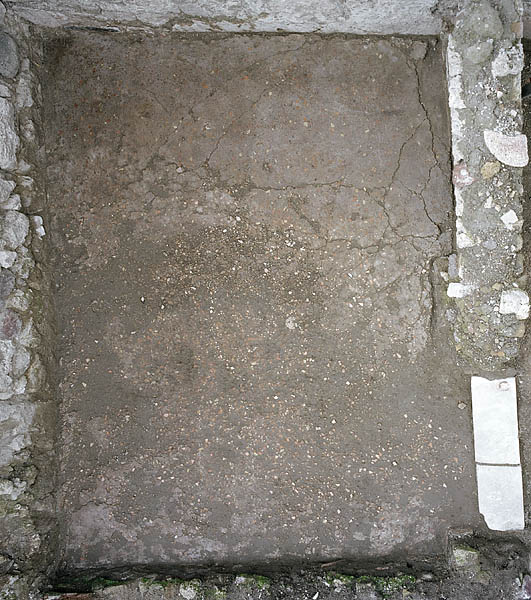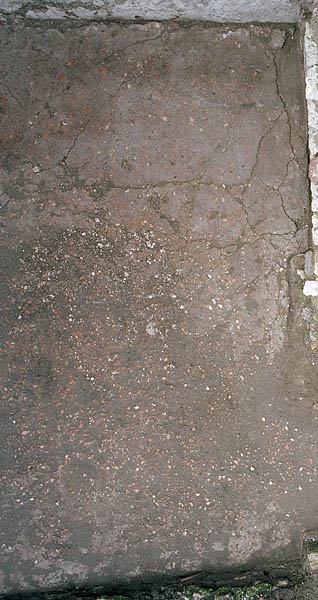Floor
Description
Henrik Boman & Monika Nilsson
The floor in room e was partly unearthed in 2004 and completely cleaned in 2005. The floor is of cocciopesto, which is badly damaged in the centre and in the south area. The northern part and the area close to the S wall are still well preserved. The floor seems to slope southwards and the centre of the floor is slightly sunken, most likely the result of the seismic activities in the area.
The terracotta content in the floor is high, shown by the broken and destroyed parts of the floor. In the centre and in the south, a tesserae pattern finally emerged during the cleaning process, but it took repeated cleanings of the floor, in combination with heavy rains, to see the pattern. The floor is not described by Mau, though he mentions the marble threshold which is still in place.
V 1,13 room e - Floor
The construction and appearance of the floor can be divided into two categories: material and decoration.
Material: Terracotta, mortar, slip and tesserae.
Decoration: Circle: central stone, rays, outer circle line.
Frame: Northern single border, line emanating from contact point at the bow of the circle, double line frame on W and E sides, southern border with double lines and fence pattern.
Terracotta: Large fragments of terracotta were used as bedding for the floor. Despite the fragmented state of the centre of the floor, we cannot estimate the thickness of neither the cocciopesto layer nor the bedding. Since the centre was sunken, we might assume that the floor is not very thick.
Slip: In the N area, a lighter surface slip is clearly visible above the terracotta cocciopesto, giving the floor a light tone in appearance. This surface slip is clearly visible in the area where no decoration was found. However, faint traces of this slip are found also on the decorated areas of the floor. Perhaps Mau did not register the floor decoration because all of it was then still covered with the slip.
Tesserae: White tesserae were used for the decoration. In some lines, however, black terrerae seem to have been used along with the white, placed close together. The main part of the decoration is heavily destroyed and some of the documented tesserae are not in their original place, hence some deviations from the pattern.
Tesserae pattern
The general outline of the pattern is a rectangular framework, with a circle inside, and a linear grid pattern in the southern end of the decorated area. The decorative pattern is placed in the E and S parts of the room.
The pattern does not extend to the N and W walls, but ends c. 1.27m from the N wall and c. 0.70m from the W wall. A single line is defining the northern end of the decoration. This line continues to the W wall in a single line of tesserae, though only a few of them are preserved in this area. The floor is well preserved in these parts so the absence of tesserae is not a question of destruction of the decoration.
The main pattern inside the rectangle is a circle (D: 1.03m) with rays (8 rays visible today) emerging from a central stone, presumably of marble.
The circle is framed by a linear pattern running in NS direction. To the north, a single line is running E-W and from this emerges the lines that connect to the rays of the circle (3 on each side). These continue down to the grid pattern in the S area. Two lines frame this arrangement without touching the circle, continuing down to the S wall.
The rays of the circle are related to this pattern since the lines emanated from the points where the rays reach the outer circle. Larger stones are placed where the rays reach the outer circle, the majority of which are white and only one black stone has been documented.
The S part of the decoration is more complex and fills a larger space than on the other sides. This area is composed by the line connected to the circle, where the internal rays touch it, the two parallel lines framing the E and W sides of the circle, and two lines running 0.34m apart E-W outside the circle. The S line is 0.60m from the W wall and the N-S lines run past this line.
Two parallel lines running E-W divide the S area of the mosaic. In the central area, what seem to be symmetrically placed south of the circle, is a field with two diagonal lines formed as a V. The lines seem only to extend within the frames described above, thought the state of the floor in this area makes it difficult to establish the pattern with certainty.


